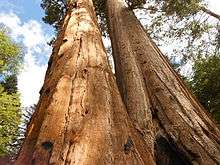Black Mountain Grove
Black Mountain Grove is a large sequoia grove containing more than 500 large trees, on the slopes of Black Mountain located between the Middle and South Forks of Tule River. It lies partly in the Tule River Indian Reservation. Black Mountain Grove is 19.3 miles long and is the sixth largest specimens in the world of all groves. It is dry and hot during summer time which is potentially negative to the forest because it is a higher risk for wildfires. During the winter time, it is cold and fresh. The Black Mountain Grove was a highlight in history because it was the conventional point to stop logging in groves. It played a significant role in the creation of Giant Sequoia National Monument. [1]
Wildlife
Before there were laws to protect the trees in the grove, more than 500 acres of non-sequoia trees were destroyed, and more than 70% of the groves were logged. The forest still has many different kinds of species of trees standing including ponderosa pine trees, willow trees, dogwood trees, white fir trees, black oak trees, incense cedar trees, and the rarest of them all, the largest sugar pine tree located at the north side of the forest. The smaller plants underfoot are fern, grasses, and forbs.
The History
In 1987, a lawsuit was filed against the Solo Timber Sale by the Sierra Club to stop logging the groves. The judgement made for that lawsuit was that the groves would be restored to their natural state. The 1990 Mediated Settlement Agreement (MSA) to the Sustainable land management plan extended the grove boundaries and prohibited timber harvesting within the groves. In 1992, President Bush visited the large sequoias and boosted the terms by completely protecting them from harvesting, mining, and development. [2]
Wildfires
Black Mountain Grove was able to overcome two wildfires, one in 1928 and one that was a little more recent, 2008. The 1928 wildfire thinned Black Mountain Grove more than the 2008 wildfire, but they both did damage to the forest. In 1928, the wildfire burned more than four square miles of trees, which left a blank spot in the forest and increased the fuel load. In 2008, about 12% of the forest burned again. Black Mountain Grove gets fire threats from around the area; for example, from Long Canyon or South and Middle Fork. There was a lot of dead wood around Black Mountain Grove, the dead wood, or just the high fuel in general, has not been removed since 2003; which means, it would burn a good portion of the sequoias if it were to catch on fire. This high fuel load caused the MSA to demand a “fuel load reduction plan,” which included plans for loggin logging. [3] [4] [5]
The grove is partly on Giant Sequoia National Monument, Tule River Indian Reservation and in private ownership and contains old and young growth sequoias. The main access to this grove is by road or hiking across country. The grove is estimated at about 3,310 acres (13.4 km2) with sequoias sprawling across the divide forming the Middle and South Forks of the Tule River.
Noteworthy trees
Black Mountain Beauty is the largest known sequoia in the grove at 32,224 cubic feet (912.5 m3) in volume and followed in size by Patriarch II and Blasted Mammoth. Blasted Mammoth may have once been the largest tree in the grove: it is broken off about 90 feet (27 m) above the ground and is still alive. Snaggle-Top has a distinctive shape. The Twisted Harlequin has pink and red bark twisting up most of its height, and the Flower Pot Tree has a Pacific dogwood growing out of its top.



Notes
- ↑ "Black Mountain Grove". Retrieved 8 December 2014.
- ↑ "Tule River Reservation Protection Project" (PDF). Retrieved 8 December 2014.
- ↑ "Wildfire Article". Retrieved 8 December 2014.
- ↑ "Fuel Load Reduction" (PDF). Retrieved 8 December 2014.
- ↑ "Society of American Foresters". Retrieved 8 December 2014.
Coordinates: 36°06′16″N 118°39′19″W / 36.10444°N 118.65528°W